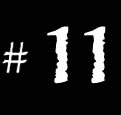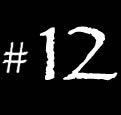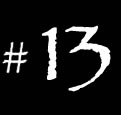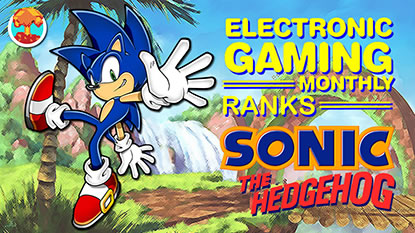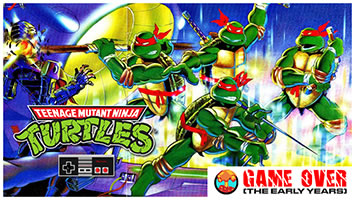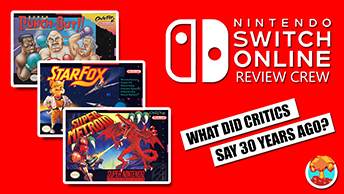- CLASSIC MAGAZINES
- REVIEW CREW
A show recapping what critics thought back
when classic games first came out! - NEXT GENERATION'S BEST & WORST
From the worst 1-star reviews to the best
5-stars can offer, this is Next Generation! - NINTENDO POWER (ARCHIVE)
Experience a variety of shows looking at the
often baffling history of Nintendo Power! - MAGAZINE RETROSPECTIVE
We're looking at the absolutely true history of
some of the most iconic game magazines ever! - SUPER PLAY'S TOP 600
The longest and most ambitious Super NES
countdown on the internet! - THEY SAID WHAT?
Debunking predictions and gossip found
in classic video game magazines! - NEXT GENERATION UNCOVERED
Cyril is back in this spin-off series, featuring the
cover critic review the art of Next Generation! - HARDCORE GAMER MAGAZING (PDF ISSUES)
Download all 36 issues of Hardcore Gamer
Magazine and relive the fun in PDF form!
- REVIEW CREW
- ELECTRONIC GAMING MONTHLY
- ELECTRONIC GAMING MONTHLY RANKS
From Mario to Sonic to Street Fighter, EGM
ranks classic game franchises and consoles! - ELECTRONIC GAMING MONTHLY BEST & WORST
Counting down EGM’s best and worst reviews
going year by year, from 1989 – 2009! - ELECTRONIC GAMING BEST & WORST AWARDS
11-part video series chronicling the ups and
downs of EGM’s Best & Worst Awards!
- ELECTRONIC GAMING MONTHLY RANKS
- GAME HISTORY
- GAME OVER: STORY BREAKDOWNS
Long-running series breaking down game
stories and analyzing their endings! - A BRIEF HISTORY OF GAMING w/ [NAME HERE]
Real history presented in a fun and pithy
format from a variety of game historians! - THE BLACK SHEEP
A series looking back at the black sheep
entries in popular game franchises! - INSTANT EXPERT
Everything you could possibly want to know
about a wide variety of gaming topics! - FREEZE FRAME
When something familiar happens in the games
industry, we're there to take a picture! - I'VE GOT YOUR NUMBER
Learn real video game history through a series
of number-themed episodes, starting at zero! - GREAT MOMENTS IN BAD ACTING
A joyous celebration of some of gaming's
absolute worst voice acting!
- GAME OVER: STORY BREAKDOWNS
- POPULAR SHOWS
- DG NEWS w/ LORNE RISELEY
Newsman Lorne Riseley hosts a regular
series looking at the hottest gaming news! - REVIEW REWIND
Cyril replays a game he reviewed 10+ years
ago to see if he got it right or wrong! - ON-RUNNING FEUDS
Defunct Games' longest-running show, with
editorials, observations and other fun oddities! - DEFUNCT GAMES QUIZ (ARCHIVE)
From online quizzes to game shows, we're
putting your video game knowledge to the test!- QUIZ: ONLINE PASS
Take a weekly quiz to see how well you know
the news and current gaming events! - QUIZ: KNOW THE GAME
One-on-one quiz show where contestants
find out if they actually know classic games! - QUIZ: THE LEADERBOARD
Can you guess the game based on the classic
review? Find out with The Leaderboard!
- QUIZ: ONLINE PASS
- DEFUNCT GAMES VS.
Cyril and the Defunct Games staff isn't afraid
to choose their favorite games and more! - CYRIL READS WORLDS OF POWER
Defunct Games recreates classic game
novelizations through the audio book format!
- DG NEWS w/ LORNE RISELEY
- COMEDY
- GAME EXPECTANCY
How long will your favorite hero live? We crunch
the numbers in this series about dying! - VIDEO GAME ADVICE
Famous game characters answer real personal
advice questions with a humorous slant! - FAKE GAMES: GUERILLA SCRAPBOOK
A long-running series about fake games and
the people who love them (covers included)! - WORST GAME EVER
A contest that attempts to create the worst
video game ever made, complete with covers! - LEVEL 1 STORIES
Literature based on the first stages of some
of your favorite classic video games! - THE COVER CRITIC
One of Defunct Games' earliest shows, Cover
Critic digs up some of the worst box art ever! - COMMERCIAL BREAK
Take a trip through some of the best and
worst video game advertisements of all time! - COMIC BOOK MODS
You've never seen comics like this before.
A curious mix of rewritten video game comics!
- GAME EXPECTANCY
- SERIES ARCHIVE
- NINTENDO SWITCH ONLINE ARCHIVE
A regularly-updated list of every Nintendo
Switch Online release, plus links to review! - PLAYSTATION PLUS CLASSIC ARCHIVE
A comprehensive list of every PlayStation
Plus classic release, including links! - RETRO-BIT PUBLISHING ARCHIVE
A regularly-updated list of every Retro-Bit
game released! - REVIEW MARATHONS w/ ADAM WALLACE
Join critic Adam Wallace as he takes us on a
classic review marathon with different themes!- DEFUNCT GAMES GOLF CLUB
Adam Wallace takes to the links to slice his way
through 72 classic golf game reviews! - 007 IN PIXELS
Adam Wallace takes on the world's greatest spy
as he reviews 15 weeks of James Bond games! - A SALUTE TO VAMPIRES
Adam Wallace is sinking his teeth into a series
covering Castlevania, BloodRayne and more! - CAPCOM'S CURSE
Adam Wallace is celebrating 13 days of Halloween
with a line-up of Capcom's scariest games! - THE FALL OF SUPERMAN
Adam Wallace is a man of steel for playing
some of the absolute worst Superman games! - THE 31 GAMES OF HALLOWEEN
Adam Wallace spends every day of October afraid
as he reviews some of the scariest games ever! - 12 WEEKS OF STAR TREK
Adam Wallace boldly goes where no critic has
gone before in this Star Trek marathon!
- DEFUNCT GAMES GOLF CLUB
- DAYS OF CHRISTMAS (ARCHIVE)
Annual holiday series with themed-episodes
that date all the way back to 2001!- 2015: 30 Ridiculous Retro Rumors
- 2014: 29 Magazines of Christmas
- 2013: 29 Questionable Power-Ups of Christmas
- 2012: 34 Theme Songs of Christmas
- 2011: 32 Game Endings of Christmas
- 2010: 31 Bonus Levels of Christmas
- 2009: 30 Genres of Christmas
- 2008: 29 Controls of Christmas
- 2007: 34 Cliches of Christmas
- 2006: 33 Consoles of Christmas
- 2005: 32 Articles of Christmas
- 2004: 31 Websites of Christmas
- 2003: 29 Issues of Christmas
- 2002: 28 Years of Christmas
- 2001: 33 Days of Christmas
- NINTENDO SWITCH ONLINE ARCHIVE
- REVIEW ARCHIVE
- FULL ARCHIVE
Capcom's Curse: 13 Days of Horror Reviews
From ghosts and ghouls to zombie invasions, Capcom has been on the forefront of horrifying gamers for more than thirty years. To help get you in the Halloween spirit, Adam Wallace is set to bring you thirteen terrifying days of Capcom reviews, featuring classics like Sweet Home, Killer 7, Maximo vs. Army of Zin, Darkstalkers 3, Devil May Cry and all three Dino Crisis games. New reviews coming every weekday between October 15 and Halloween day. Be afraid, horror junkies, because you are already under Capcom's Curse!
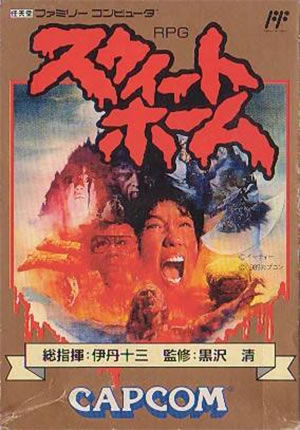
It's always weird to see the genesis of an idea. Resident Evil is considered one of the fathers of survival horror along with Alone in the Dark. However, experts kept saying that the true originator of the idea was an 8-bit Japanese game called Sweet Home. After playing it, I definitely see the origin of several elements in Capcom's more famous game and how much refinement was needed. The story revolves around a team of investigators. They entered the secluded mansion of a famous painter who, it turns out, is dead. The ghost of the painter traps the team inside. They have to escape, and the answers lie in the artist's work. It's a rather sophisticated story for 1989; even Final Fantasy's story was trite compared to Sweet Home. I just wish there was more personality in the members of the investigative team that serve as the protagonists. They hardly speak except to partner up or ask for help. Aside from their tools, I can hardly tell Kazuo from Asuka. [READ FULL REVIEW]
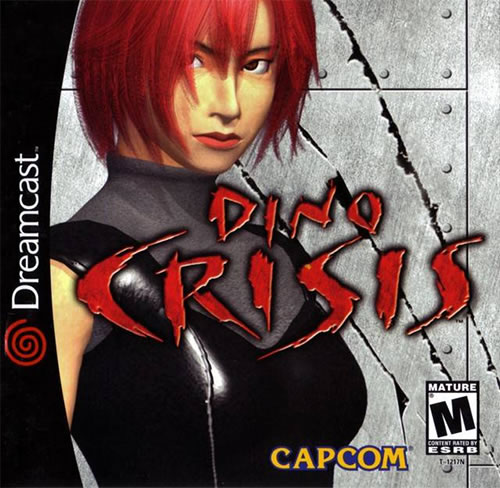
Jurassic Park was an amazing film back in the 90s. Not only was it a wonder to see those dinosaurs on the big screen, but it had plenty of scares for a PG-13 movie. Obviously, the developers at Capcom were fans, as well. They apparently went out of their way to try to recreate that sense of dread in Dino Crisis. While it doesn't quite reach the heights of Spielberg's masterpiece, it is still a good survival horror game with HEAVY emphasis on the "survival" part. Like with the Resident Evil franchise, Dino Crisis is a horror game revolving around science experiments gone horribly wrong. A missing scientist who'd been trying to develop a new form of energy suddenly turns up at a remote facility. As the rescue team consisting of the leader Gail, the tech expert Rick, and the player character Regina search for him, they learn that the new energy experiments opened a hole into the past, pulling the killer lizards into the present. [READ FULL REVIEW]
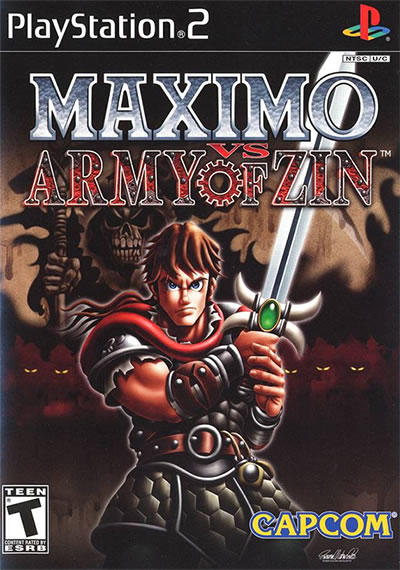
I'm not angry. I'm just disappointed. Maximo: Ghosts to Glory was a decent attempt to bring the Ghosts 'N Goblins formula into the modern era with just a few significant issues keeping it from greatness. I had hoped that the follow-up Maximo Vs. Army of Zin would fix those issues and be the game I wished the first one could've been. Unfortunately, while the sequel took a couple steps forward, it also took several steps back, and its heart-shaped boxers fell down. This one takes place a few months after the first Maximo game. An evil force powered by unlimited souls and technology had been unleashed after years of being sealed in a vault. While the first game had some creativity with its story, the second is very cliched. The only unique element is the "magic infused with technology" angle. While story is usually something that can be safely ignored in a platformer, the plot downgrade here from the original actually hurt it. [READ FULL REVIEW]
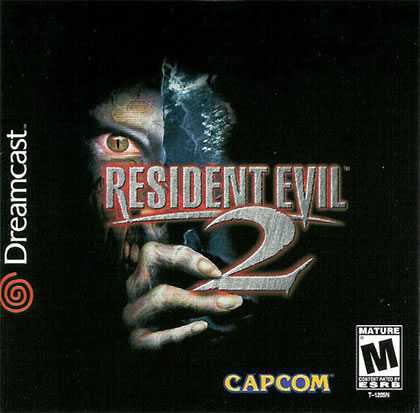
The original Resident Evil is one of my favorite games of all-time. While the gameplay is a little clunky and the voice acting is unintentionally hilarious, the story is excellent, and the sense of atmosphere is peerless even today. Needless to say, I approached the sequel with anticipation and apprehension when it first released in 1999. There's a long history of sequels royally screwing up. My concern was baseless as Resident Evil 2 was fantastic as well, and the Dreamcast version released a year later is, no doubt, the best version of the game that you can get. The story picks up two months after the events of the original game. The T-Virus infection had escaped the Spencer Mansion and infected Raccoon City itself. The game is played from the perspective of two new arrivals to the city, rookie cop Leon and Chris's sister Claire. [READ FULL REVIEW]
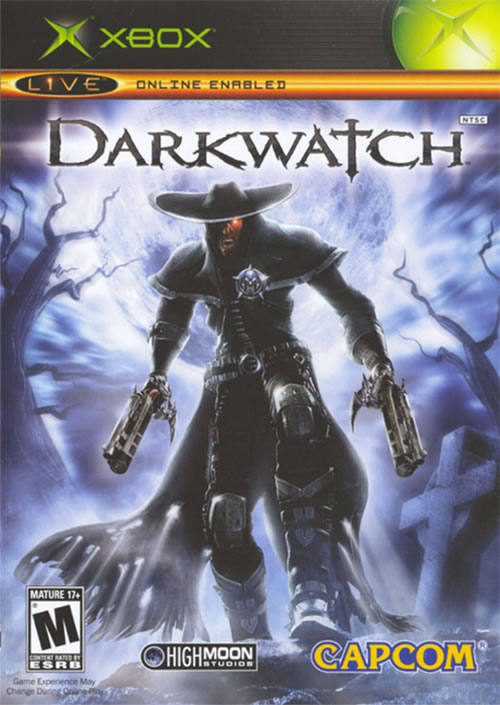
Capcom had always been a Japanese company first and foremost. The most they usually ever have to do with the West is when they need to localize their very Japanese games. They very rarely actively collaborate with external American developers. I really have to wonder why since Darkwatch, their collaboration with High Moon Studios, gave them an absolute gold rush. Darkwatch combines two things that I never imagined could go well together, the Old West and vampires. Players take control of Jericho Cross, a former outlaw. I say "former" because, after attempting to rob the wrong train, he releases and gets cursed by the vampire lord Lazarus. His only hope to save himself is to join the Darkwatch, an organization that hunts down nightmare creatures. Unlike most stories in first-person shooters that are just there to provide an excuse for all the shooting, story actually takes a major role here due to its morality system. [READ FULL REVIEW]
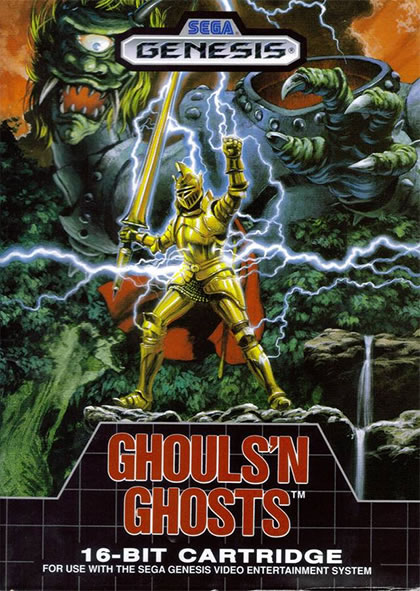
When people go looking for games known for their outright infuriating level of difficulty, certain series always spring to mind. There are people who go for older series like Ninja Gaiden or current challenges like Dark Souls. Then there is the Ghosts 'N Goblins series, the games that revolve around a knight named Arthur rescuing the Princess Prin-Prin from demons. Even among the hardest games in existence, this series is infamous, not just for the relentless hordes and Arthur's vulnerability, but also because of the cruel pranks the game plays on the players. These pranks range from tricking people into giving up their best weapons to the rage-inducing ending that forces a second playthrough. While all the games in this series can make people rip their hair out, the Genesis entry Ghouls 'N Ghosts makes the torture more enjoyable. The plot in this sequel is very similar to the first game. Arthur needs to rescue Prin-Prin again, but there are two key differences. [READ FULL REVIEW]
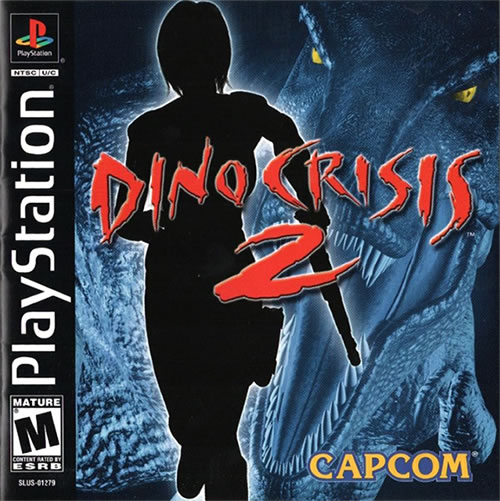
It can be very chancy to make radical changes in a sequel. Even if the results turn out to be positive, the changes could alienate the fans. We all saw the reactions when Rare made the third Banjo-Kazooie game into an open world driving game. While the changes made in Dino Crisis 2 weren't THAT earth-shattering, it still is a very different beast from the original, and the alterations to the formula resulted in a much better game overall. The story picks up where the original left off. Even though Dr. Kirk was retrieved and his facility was shut down, research into Third Energy continued. Another accident occurs at an island research station, and, instead of bringing dinosaurs into the present like last time, the facility got pulled into the past. A strike team led by returning heroine Regina and newcomer Dylan travel through the time distortion to save the scientists and retrieve the data. [READ FULL REVIEW]
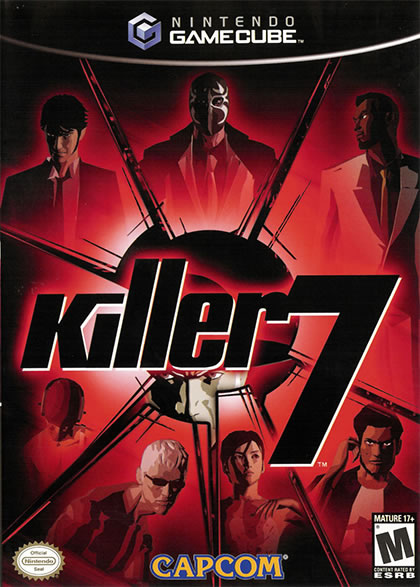
It takes something truly special to turn a game developer into a celebrity. Shiguru Miyamoto created the most lovable characters in history with Mario and Link. Tomonobu Itagaki brought on shameless sex appeal with the Dead or Alive games. David Cage made emotional roller coasters that weren't afraid to rip players to shreds. The same can be said of Goichi Suda, better known as Suda51, who gained celebrity status by just being REALLY friggin' weird. With games like No More Heroes, Shadows of the Damned, and Lollipop Chainsaw, Suda51 managed to create fun action games that were so bizarre in their look and tone that players are often left scratching their heads and asking themselves, "What the hell did I just play?". I found myself saying that a lot after playing Suda's first big release Killer7. The story revolves around attacks by a terrorist group that's using a virus to mutate people into suicidal psychos. These attacks threaten a peace accord between America and Japan; so, the US sends an old fart in a wheelchair to sort it out. [READ FULL REVIEW]
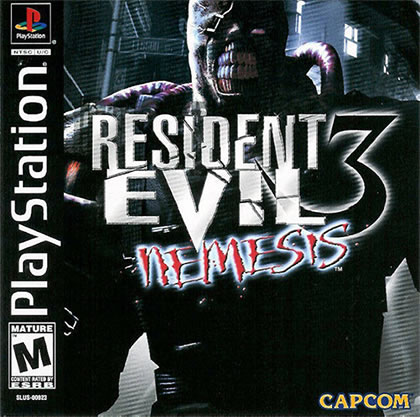
Sometimes I find it hard to know what to think about a game. It can be especially hard when it's an installment in a great series. The first Resident Evil is one of my favorite games of all time, and the second was one of the greatest follow-ups ever made. Those accolades would be enough to ensure that the third game Nemesis would be a disappointment. After all, once you reach the top, there's only one way to go. However, Resident Evil 3, while decent, has enough problems gnawing at it even without the sky-high expectations from the previous games. The third game's plot is all over the place in every sense. Picking up in the middle of the zombie apocalypse attacking Raccoon City, the game follows Jill from the first game as she tries to escape the dying town. However, setting roadblocks for her is the Umbrella Corporation, the company behind the infection. (NOTE: I would have given a spoiler alert for those who hadn't played the first two games, but those people had twenty years to play them. So, whatever.) [READ FULL REVIEW]
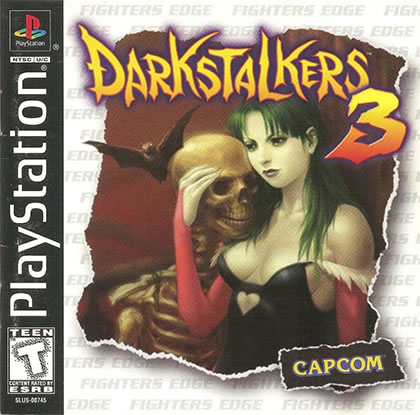
If there's one genre that Capcom knew how to do near perfectly for decades, it was 2D fighting games (3D is more iffy for them). Their hand-drawn fighters ran the gamut from the highly technical pugilism of Street Fighter 2 to the chain-combo craziness of Marvel Vs. Capcom. In the middle of that range lay the horror-themed Darkstalkers series. While the third game in that series provided a nice little change of pace in the arcades, the Playstation port is almost as painful as a Soul Fist to the face. Story has never been a real concern for Capcom's fighting games, and Darkstalkers 3 is no different. The Vampire Lord Jedah invites the Night Warriors to his realm to take their power. Fortunately, that flimsy premise does draw in some creative characters including the pint-size merc B.B. Hood, the mummy Anakaris, and the Sasquatch to join classic characters like Donovan, Felicia, and the face of the series Morrigan. [READ FULL REVIEW]
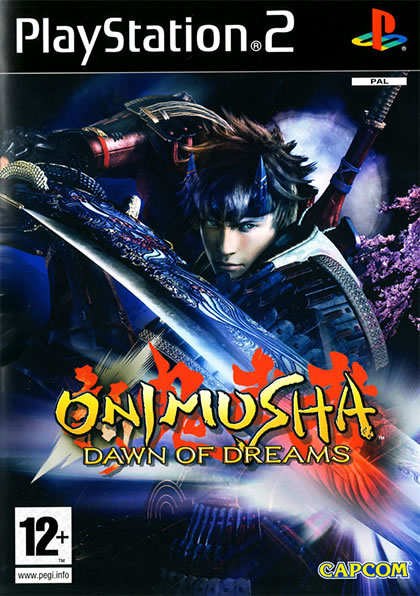
It's always a problem when an intended trilogy ends. On the one hand, you want to satisfy an audience who probably wants more. On the other, it becomes too tempting just to go through the motions with nothing new to add to the franchise. The Pirates of the Caribbean movies are a perfect example of this phenomenon. The same can also be said of the Onimusha franchise with Dawn of Dreams feeling just as unnecessary as On Stranger Tides. Even the story makes this game look like an afterthought. The fourth Onimusha game picks up twenty years after the fall of the demon-possessed Nobunaga Oda who was the villain of the first three games. Hideyoshi now controls Japan and has brought back the Genma. The nation's hope rests with five warriors led by a half-demon named Soki. While the actual plot is a very poor retread of the first game, the interactions among the heroes hold the game together. It's also much goofier than the original trilogy. Some may like that, but I didn't. [READ FULL REVIEW]
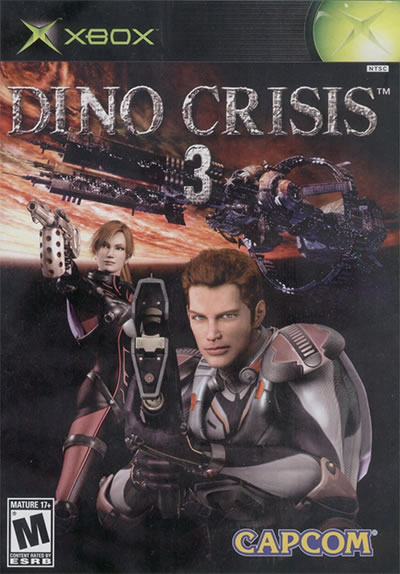
One of the most common elements in written work is the fatal flaw. It is that one element that completely destroys an otherwise near-perfect character. While it does feature prominently in stories, it's rare to find it in real venues like the world of game design. I mean, usually a failed game has so many issues that there isn't one that can be named as THE straw that broke the camel's back. However, that is certainly the case with Dino Crisis 3, a game that could've been great were it not for one thing that almost completely destroyed it. The story has virtually nothing to do with the first two games apart from the existence of dinosaurs. Taking place 500 years in the future, the colony ship Ozymandias reappears after being missing for 300 years. A strike team investigates and discovers mutated lizards had overrun the ship. Yes, this game's plot basically combines Jurassic Park with Event Horizon (with a sprinkling of Alien for good measure). That's actually awesome. The completely gonzo plot makes this one the most unique survival horror game Capcom wrote. [READ FULL REVIEW]
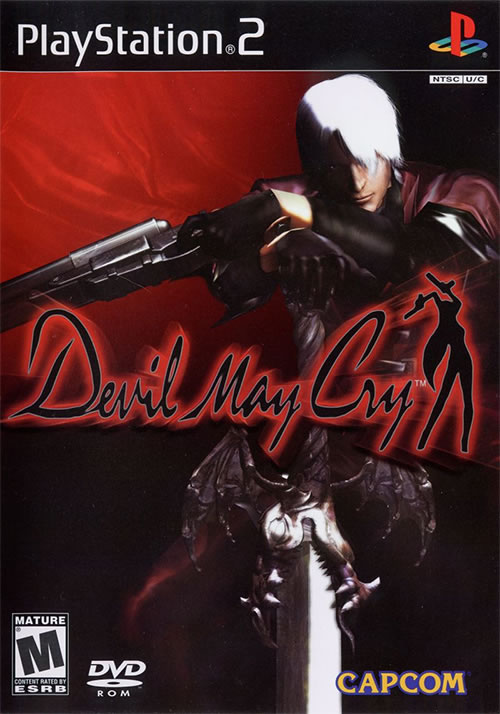
It's funny how things can turn out. While in the process of making the prototype for Resident Evil 4, the producer Shinji Mikami noticed a strange glitch where enemies kept flying up when they got hit. Rather than try to fix the glitch, Mikami decided to make it an active part of a new game. That idea gave birth to Devil May Cry, and it is both a gorgeous piece of demonic artwork and one of the biggest causes of broken controllers in the Playstation 2's catalog. The plot is very basic for this game. The hero is Dante, a monster hunter for hire who is part-human, part-demon, and all stylish with his red leather, big-ass sword, and twin pistols. He gets hired by a woman named Trish to hunt down the demon Mundus who is returning after 2000 years. The story really only serves as an excuse for the scenarios the game presents. In fact, the plot only shows up at the very beginning of the game and the very end, complete with all the hammy acting of a lame anime. While weak plots are a common trait for almost all the games of this series, the first one has the weakest in my opinion. [READ FULL REVIEW]
HOME |
CONTACT |
NOW HIRING |
WHAT IS DEFUNCT GAMES? |
NINTENDO SWITCH ONLINE |
RETRO-BIT PUBLISHING
Retro-Bit |
Switch Planet |
The Halcyon Show |
Same Name, Different Game |
Dragnix |
Press the Buttons
Game Zone Online | Hardcore Gamer | The Dreamcast Junkyard | Video Game Blogger
Dr Strife | Games For Lunch | Mondo Cool Cast | Boxed Pixels | Sega CD Universe | Gaming Trend
Game Zone Online | Hardcore Gamer | The Dreamcast Junkyard | Video Game Blogger
Dr Strife | Games For Lunch | Mondo Cool Cast | Boxed Pixels | Sega CD Universe | Gaming Trend
Copyright © 2001-2025 Defunct Games
All rights reserved. All trademarks are properties of their respective owners.
All rights reserved. All trademarks are properties of their respective owners.

















